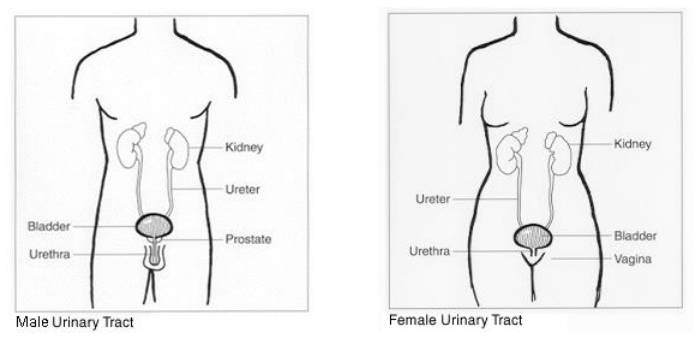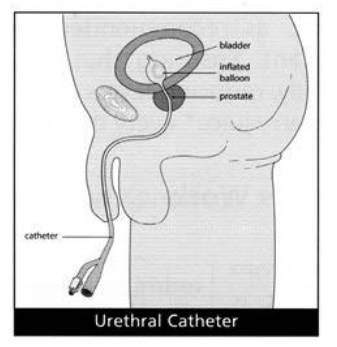Going Home with a Catheter
Please note, this page is printable by selecting the normal print options on your computer.
This booklet has been produced to help you or your carer look after your catheter at home.
If you have any questions when you have read this booklet please ask your nurse prior to discharge from the hospital. On discharge a ward nurse will refer your care to the district nurses based at your General Practitioners (GP) surgery. If you have any questions or concerns about your catheter contact your district nurse or (GP) once you are at home.
The Urinary System
The kidneys produce urine, which passes down the ureters into the bladder where it is stored. Urine is expelled from the bladder through the urethra.

What is a Catheter?
A catheter is a hollow tube which drains urine from the bladder into an attached catheter drainage bag. You will not need to pass urine yourself. Alternatively you may be offered a catheter valve that attaches to the end of your catheter but this will be discussed with you by your nurse/doctor, because catheter valves are not suitable for all patients.
Why is a Catheter used?
About 10% of all hospital admissions will have a catheter fitted at some time. There are many reasons why a catheter is necessary. An explanation will be given to you prior to discharge home from hospital and how long the catheter needs to stay in. You will also be taught how to look after your catheter and how to manage the leg and night drainage bags.
How does a catheter stay in the bladder?
At the tip of the catheter is a small balloon which is inflated with water after the catheter is put in, this stops it from sliding out.

Common catheter problems and how to deal with them
Bladder spasms or cramp in the abdomen are common when a new catheter is put in and it may sometimes cause a small leakage of urine around the catheter. Medication can sometimes help relieve the problem however it is not suitable for all patients. This will need to be discussed with your GP.
If no urine drains from your catheter check:
• Is the tubing kinked?
• The bag should be below bladder level
• Are you constipated?
• Is the drainage bag connected the right way up?
• Have you been drinking enough? (at least 1-2 litres in 24hrs)
Try walking or moving around as this may dislodge a blockage. If nothing drains and you are in pain, contact your nurse or GP for advice. If your catheter falls out – immediately contact your nurse or GP for advice. If this is out of your surgery’s working hours contact NHS Direct for advice.
Urine Infection signs – if you develop a fever, or have any burning, stinging or offensive, cloudy smelling urine this may indicate an infection, and you will need to inform your nurse/GP immediately. If urine leaks out around the catheter- this is not a serious problem do check:
• There are no kinks in the catheter or the tubing
• There is not a blockage
• You are not constipated
However some patients with catheters experience problems with leakage of urine from around the catheter and this can be a long term problem. This may be caused by the bladder muscle overacting due to the presence of the catheter, which is a foreign body. This may be treated with medication to stop the bladder contracting. If the problem continues contact your GP for advice. If you see blood in your urine – this may be due to catheter trauma (the tube may have been accidentally pulled) or be a sign of a urine infection. Increase your fluid intake as this may help to clear the colour of your urine. If your symptoms persist contact your GP.
Frequency of catheter changes
This depends on the type of catheter you have. There are two types of catheters:
Short term catheter: this can remain in the bladder for one month.
Long term catheter: this can remain in the bladder for three months.
Catheter Hygiene: To avoid the risk of infection, follow these simple instructions.
• Always wash and thoroughly dry your hands before and after dealing with your catheter and drainage bags.
• You can have a bath and shower with the catheter in place: Firstly empty the catheter bag. Once finished, dry the catheter and bag with a towel.
• The skin around the catheter should be washed daily with unscented soap and water, rinsed and dried thoroughly with a clean wash cloth. Using down ward strokes were the catheter tubing enters your body. This will prevent infection and the build up of encrustations around the catheter site. This should be done at least daily or twice daily.
• Do not use cream or talc around the catheter.
Emptying your catheter bag:
You will be shown how to empty the leg drainage bag by opening the tap at the bottom of the bag. Empty it into the toilet if possible. Make sure that you close the outlet tap properly after emptying the bag.
If you are unable to get to a toilet, drain the urine into a suitable container. Advice will be given to you by your nurse. The leg bag should be emptied when it is three quarters full as this will prevent it becoming heavy and causing discomfort. This is only a guide and you should use your judgement to ensure your comfort and well being.
What to do at night
At night a larger drainage bag (night bag) can be connected to the leg bag. Empty your leg bag prior to attaching the night bag. Once you have connected the night bag, open the drainage tap on the leg bag. This will ensure that your urine drains from the leg bag into the night bag. The night bag can be connected to a stand beside your bed. Each morning, close the drainage tap to the leg bag
and disconnect the night bag and empty it down the toilet. The leg bag can stay connected to the catheter for 5-7 days, leaving the leg bag connected in this way helps to reduce the risk of infection.
The night bag should be disposed of daily or every 5-7 days depending on the night bag that is provided and manufactures guidelines.
Disposal of drainage bags
First empty the bag of urine into the toilet so it is empty. Put into a plastic bag and placed in your dustbin.
Socialising, Exercise, Holidays and Work:
Having a catheter should not prevent you carrying out your normal activities. If you are going on holiday and you have a permanent catheter bag speak to your nurse, because a catheter valve, may be appropriate for a short term solution.
Sexual activity
Sexual activity is possible for both men and women with a catheter in place. Men should empty their catheter drainage bag. The catheter is folded down the length of the penis and a condom should be placed over the catheter tube and penis. After intercourse wash the genital areas.
Women should empty their catheter drainage bag. The catheter tube should be placed upon the stomach and secured. After intercourse wash the genital areas.
What to eat and drink
Drink at least two litres of fluid a day. Keep a cup of water by your bed at night so that you can have a drink if you wake. Avoid caffeine drinks such as carbonated drinks, coffee or tea as this may irritate your bladder. Avoid constipation as this can prevent the catheter draining properly or cause leakage of urine around the catheter. Ensure you have plenty of fibre in your diet, i.e. brown bread, fruit and vegetables. Drink plenty of fluids and if you are able, take plenty of exercise. Speak to your nurse or doctor if you are prone to constipation for necessary advice.
Further Contacts:
Your District Nurse works from 9am-5am 7 days a week
Twilight Nurses work from 8pm-1am contact phone numbers 01908 303048 or 07836336777
Your own GP
NHS Direct www.nhsdirect.nhs.uk
Urology Nurse Practitioner 01908 996 902. Answer phone service available.
